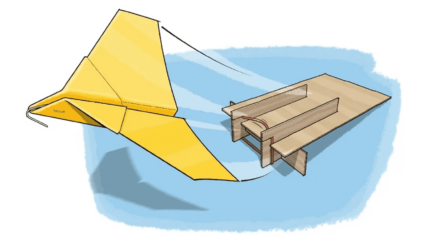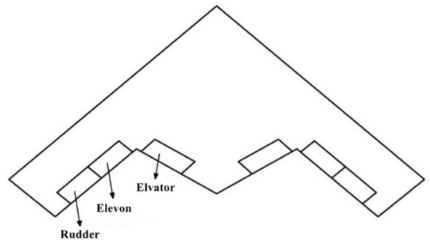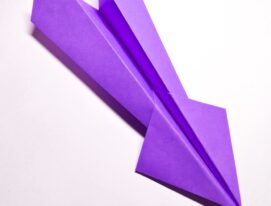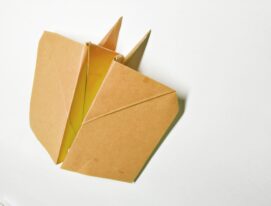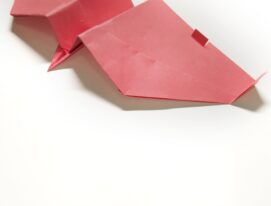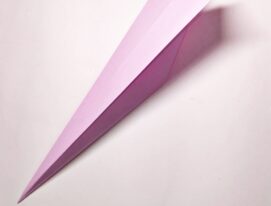The Science of Paper Airplane Flight
The paper airplane is man’s first attempt to overcome the resistance of gravity. The father of paper airplanes is considered by most to be George Cayley, a famous inventor and aviator from England. He practiced a lot in launching linen gliders from the hillside with the help of poles to which they were attached. The launching was done on the principle of javelin throwing.
It was these experiments that showed that kites launched into the air could fly long distances, and later it became an amusement for children.
In order to launch an airplane, you not only need to master the art of origami, but also understand math, physics, and even topology. But that’s not all. To properly and successfully launch a paper airplane, you will also need knowledge of aerodynamics. In this article, we are going to point out the “scientific” sides of paper airplane crafting in the origami technique.
Speaking of origami, there is even a special term for paper airplanes — aerogami. Aerogami is a type of origami, crafts of flying machines from paper, such as airplanes, parachutes, helicopters, paper kites, and others. The models are folded from a single sheet of paper, eliminating cutting, gluing, and joining with scrapers, etc. Today Aerogami is no longer just fun for one or two people, but a serious hobby in which there are held competitions all over the world.
A key criterion for a successful glider is that the center of mass must be in the right place. Good paper airplanes achieve this by using the leading edge folded several times or by using an extra paper clip.
Good paper airplanes must be able to withstand a short and fast throw. Once the thrust stops, the airplane needs to maintain a balance of the remaining forces – drag, lift, and gravity – to stay in the air.
Below we’ll talk in detail about each of the criteria for successfully flying your paper airplane.
First, a little bit of theory
Aerodynamics is the science of the laws of air motion and force interaction between a body and the air around it (translated from Greek “aero”-air, “dynamis”-force).
Aerodynamics is the theoretical basis of aviation and rocket technology.
To calculate the strength of an airplane, study its stability, and determine its flight properties, it is necessary to know the aerodynamic forces and moments that arise during the flight of the airplane. Only with the advent of aerodynamics did, the rational design of airplanes become possible.
To understand the basic physical forces affecting the flight of a paper airplane, you will have to delve into the basics of physics and aerodynamics. If to understand, everything is quite simple. Let’s start by talking about the simplest concepts.
The main forces that determine the flight of a paper airplane are the lift force, the force of gravity, and the force of air resistance.
Lift force is an upward-directed force arising when the airplane moves in the air medium.
The force of gravity is the force caused by the Earth’s gravitational pull.
The air resistance force is the force that prevents forward motion.
Traction is the force caused by the airplane’s engine. The paper airplane is propelled only by the energy of your throw.
Now, let’s talk about each of the parameters in more detail, because that’s when you’ll have the perfect paper airplane that can compete with the record holders!
Paper Airplane Rotational Axes
Like any other physical object, a paper airplane has three axes along which it rotates. In this case, they are called roll, yaw, and pitch axes. Each of them corresponds to the more familiar X, Y, and Z axes from geometry classes.
Accordingly, each of the axes is responsible for the rotation of the airplane in different directions. Thus, the Roll axis is responsible for the rotation of the paper airplane around the longest axis; the Yaw axis is responsible for rotating the airplane around its center point to the sides, and the Pitch axis is responsible for rotating the airplane up and down, also from its center point.
Paper Airplane Physical Forces
As mentioned above, four basic physical forces affect the flight of any airplane:
- The force of gravity is a constant force that pulls the airplane toward the ground.
- The thrust force, which comes from the engine and propels the airplane forward.
- The drag force is opposite to the thrust force and is caused by friction, slowing the airplane and reducing the lift of the wings.
- The lift force that is produced when air moves over the wing creates a reduced pressure
As for the paper airplane, the same fundamental principles apply. The main reason why a paper airplane flies, in the absence of a wing profile like that of a real airplane, is that, although its wing is flat, during flight it is positioned at an angle to the airflow, which creates an angle between the construction axis of the airplane and the velocity vector.
The paper airplane has no engine, so there is no thrust. The paper airplane is propelled only by the energy of your throw. When designing a paper airplane, it is important to consider the ratio of these forces – their balance.
Balancing is extremely important for airplanes launched outdoors. They must maintain the correct position despite air fluctuations. Airplanes launched indoors benefit from shifting the center of gravity to the nose. These models fly faster and more stable and are easier to launch.
Paper Airplane Control Surfaces
So, we already know that the flight of any airplane, both real and paper airplanes, is determined by: lift force – upward directed force arising from the movement of the airplane in the air medium; gravity – the force caused by the attraction of the Earth; air resistance – is the force that prevents forward movement; thrust – the force arising from the operation of the airplane engine. Now let’s understand the design, because, an extremely important point in aerogami is the correct location of the center of gravity. For example, the speed and trajectory of the flight can be corrected by bending the rear part of the wing-like real flaps, and slightly turning the paper keel.
The term control surface describes the moving part of any external surface of an aircraft. For an airplane, these are the rudder, the elevator, and the ailerons. The elevation rudders control the up and down movement of the airplane, the directional rudders control the right and left movement, and the ailerons control the roll.
For all paper airplanes, without exception, the rule applies the thinner the wing, the better. Paper airplane wings are flat, they have less drag than thick or curved ones. As for shapes, the wings of paper airplanes are most often either rectangular or triangular.
Moreover, when creating a paper airplane you should pay attention to an important detail – the ratio of the wing length to its width. The length of the flight of your creation depends significantly on it.
Paper Airplane Rudders
For paper airplanes, the elevator and rudder represent the most important control surfaces. From a technical point of view, most paper airplanes use what is known as a mating wing. This means that the main wing transitions smoothly into the tail. On such wings, some control functions are combined. For example, the rudder works as an aileron and is therefore called an elevon.
For simple paper airplanes, the rudders are rarely used in flight control, but when crafting more complex models, they can significantly improve the characteristics of your aerogami.
Paper Airplane Ailerons
Ailerons are the control surfaces of a paper airplane that control roll. In other words, they are flaps, so ailerons can only be found on airplanes with wings and tails. Most airplanes have flaps at the rear of the wing. Ailerons are similar in function to rudders.
Imagine that air is reflected downward only from the right wing of a paper airplane. This would cause the left wing to go down while the right wing would go up. Without ailerons, the airplane will just start going up in circles.
Normal rudder movement does not provide a high level of precision and controllability when the wings are tilted (roll), which is why ailerons are important.
Paper Airplane Elevation Rudders
For paper airplanes, the elevation rudder and directional rudder are the most important control surfaces. The elevation rudder affects the upward and downward motion of the airplane. If the elevator rudder is raised, the air hits the airplane and pushes upward, causing the tail of the airplane to sink low and the nose to rise.
The elevators are on the tail of the airplane and look like horizontal flaps. With their help, you can stabilize the flight path of your plane by slightly tucking, or vice versa spreading the elevators. If your airplane is constantly diving downwards, this is also an elevation rudder problem.
Paper Airplane Elevons
Unlike the rudder, the elevon controls the up and down movement of the airplane and acts as both rudder and aileron, while also controlling roll, but only on paper airplane models with deltoid wings
How the elevons are bent will also determine how much they affect pitch and roll. Let’s explain: if the elevons are bent in one direction, they work like ailerons, i.e. control roll; if the elevons are bent differently, they control both roll and pitch simultaneously.
Paper Airplane Gravity Center
The shape of paper airplanes determines where their center of pressure (the point where the lifting forces are applied) will be located. The center of gravity should be in front of the center of pressure – this allows the plane to move forward after the throw.
You can determine the center of gravity of a paper airplane by using a needle and thread. Pierce the airplane with the needle and let it hang on the thread. The point at which the plane will balance perfectly flat wings is the center of gravity.
The compromise between wing shape and center of gravity is the basis of paper airplane construction. To keep the glider flying farther, it doesn’t need to be thrown too high, so you can sacrifice some of the stiffness of the structure in favor of wider wings (this allows the glider to stay in the air longer).
Paper Airplane Dihedral Angle
Stability in flight is also determined by the angle of transverse bending of the wing plane – in airplane design this is the angle of attachment of the wings to the fuselage of the airplane. If the wings are located above the horizontal – they have a positive angle of transverse bending of the wing plane. If the wings are below the horizontal, they have a negative angle.
The positive angle helps to place the center of pressure above the center of gravity, thus creating conditions for stable flight. Therefore, when launching a paper airplane, you should always correct its wings by raising them.
Conclusion
Paper Airplane designs vary considerably depending on the purpose for which they are built. For example, airplanes for high-speed flights resemble a dart in shape, they are as narrow, long, and rigid, with a pronounced shift of the center of gravity to the nose. Airplanes for the longest possible flights have a large wingspan and are well-balanced.
The ideal shape for a glider involves very long and narrow wings, similar to those of a gull or albatross. This wing configuration has a large relative elongation – in other words, the distance from one wing tip to the other is much greater than the distance from the leading edge of the wing to the trailing edge. However, creating a paper airplane with a wing that resembles a gull-wing presents a challenge for the designer. Paper wings must withstand a powerful throw, so it is very difficult to design wings with high relative elongation for a paper airplane.



